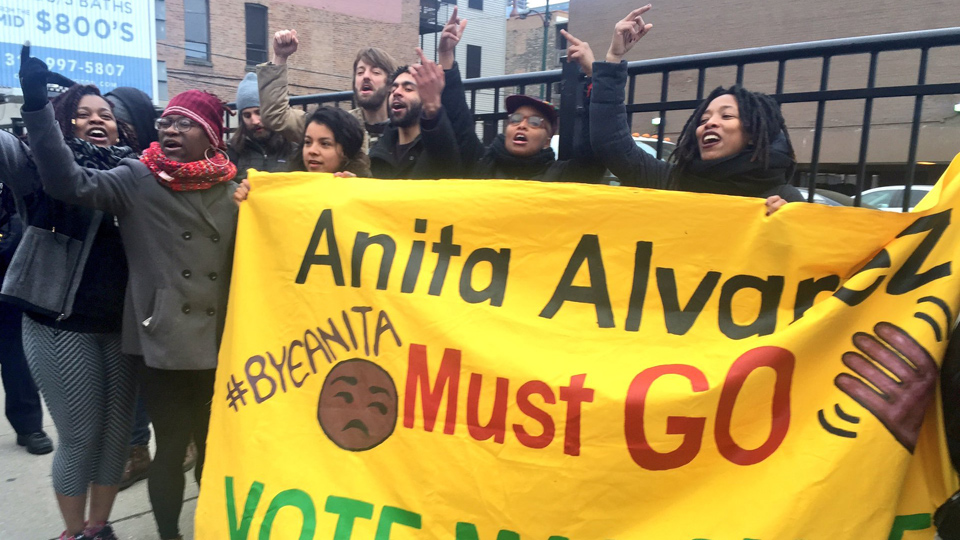
CHICAGO – This city’s black and brown youth are reshaping electoral politics through a collaborative effort between direct action organizers and registered voters. The city of Chicago and suburban Cook County have historically struggled with voter turnout; less than a third of eligible voters showed up to cast a ballot for the primaries in March. This time around, however, young people are taking the lead in ensuring that they are being represented and that their voices are being heard.
Community-based efforts to register more voters have been underway since March of 2016 when Cook County State’s Attorney Anita Alvarez was still in office. Just a month prior, a Chicago Tribune poll found that 34 percent of registered Democratic voters supported Alvarez for the position. Alvarez’s closest opponent, Kim Foxx, trailed seven points behind her. To the surprise of many, Alvarez eventually lost her bid for reelection to Foxx, taking in only 29 percent of the final vote.
The question on everyone’s mind in the aftermath of the election: How did voters reverse the tide on a seemingly secure victory for Alvarez? The short answer: Chicago’s youth organizers. A Cook County state’s attorney race would typically have received little media coverage. In this case, however, Alvarez had been heavily implicated in the cover-up of Laquan McDonald’s death.
McDonald was a black teenager gunned down by a Chicago police officer in October 2014. A year later, in November 2015, a Cook County judge ordered the release of a graphic dashboard video that showed McDonald being shot 16 times during an encounter with police. After the footage was released to the public, community leaders successfully pushed for further investigation of the shooting. Alvarez was the leading prosecutor on the case at the time of the shooting and faced criticism for the 13 months it took her to charge the officer with McDonald’s death.
The public outrage around the mishandling of McDonald’s case was largely directed at Mayor Rahm Emanuel, then-Police Superintendent Garry McCarthy, and then-State’s Attorney Alvarez. Calls for Emanuel’s resignation and hashtags like #AdiosAnita and #ByeAnita spread across social media platforms. Alvarez defended her actions, insisting that the Cook County state’s attorney’s office and the FBI had started working together on the Laquan McDonald case in December of 2014.
Alvarez also came under fire for her extensive history of clearing police officers involved in fatal shootings. According to public records, she had declined to file charges in such cases at least 68 times in a span of seven years; in most cases, no documentation to justify such decisions was provided. Despite increasing outrage, Alvarez dismissed demands for her resignation in the days following the release of the dashcam footage, claiming that she had to make decisions every day that “might not be so popular.”
After the Chicago Tribune poll was released in February of 2016, several community-based organizations gathered to strategize ways in which they could get Alvarez out of office. Efforts from organizing collectives including Assata’s Daughters, Black Lives Matter, Black Youth Project 100 and FLY resulted in an orchestrated range of political actions throughout the city of Chicago.
Labor around the #ByeAnita campaign was meticulously divided amongst those who chose to partake in direct-action-based approaches (protest, disruptions, banner drops, etc.), and those who focused on getting her voted out of office. Organizers shut down Alvarez’s fundraisers and speeches, at one point derailing three separate events over a 24-hour period. A number of hand-crafted “Bye Anita” banners were dropped at 16 locations across the city in remembrance of the 16 shots that killed Laquan McDonald.
While the #AdiosAnita campaigners chose not to endorse any particular candidate, they focused efforts on encouraging voters to get corrupt officials, like Alvarez, out of office. Youth took up phone banking and registering voters door-to-door in black neighborhoods, moves that ultimately led to Foxx’s electoral victory.
Chicago’s youth set a precedent for the city that day. Through a combined effort between radical grassroots movements, young people engaged with the electoral process in a way that did not present it as an ultimate solution, but rather as one method of social progress in a multi-faceted system.
The #ByeAnita campaign serves as a template for the type of organizing work that fosters both direct action and electoral participation. Alvarez being strategically voted out of office is directly correlated to the movement work that led to the eventual conviction of the police officer who shot Laquan McDonald.
While city officials continually seek to create a better system of accountability for law enforcement, the real shift comes from within our electoral system. Organizations like Chicago Votes are now encouraging a new generation of leaders to become involved in government and politics and to challenge antiquated laws within Chicago and Illinois as a whole.
Chicago’s black and brown youth set the bar for progressive politics, both on the picket lines or at the polls. With November’s midterm elections almost here, the power of the people will surely be noted at the ballots, and our youth will have another opportunity to showcase their unified strength.










